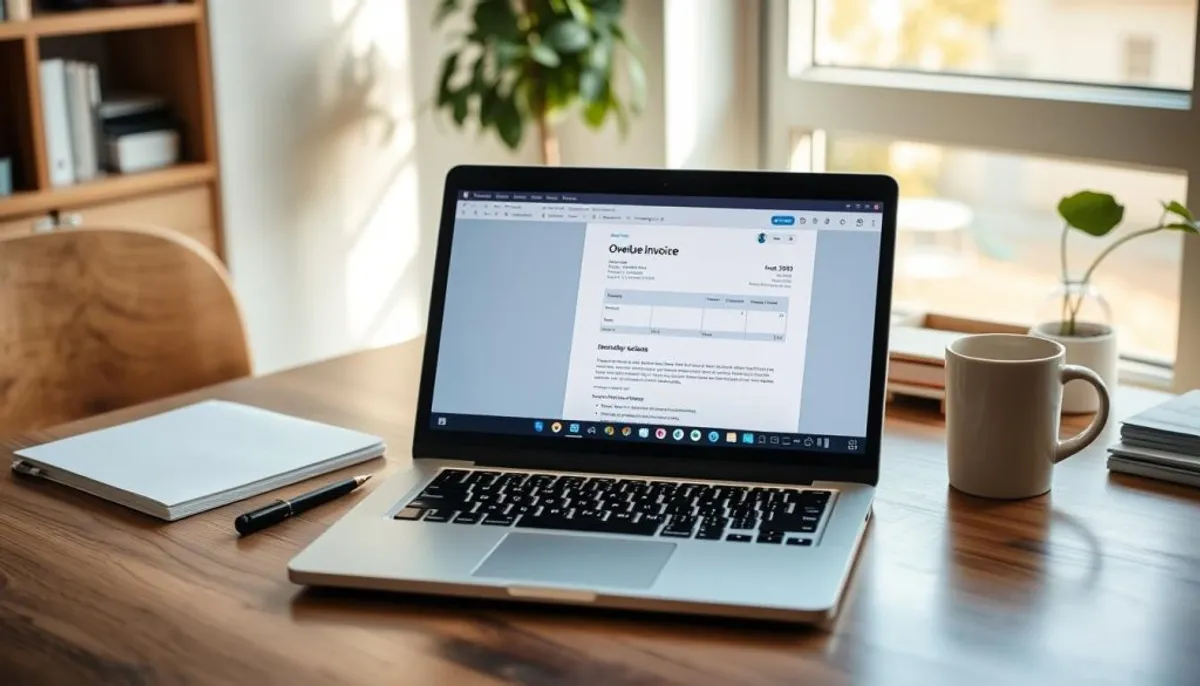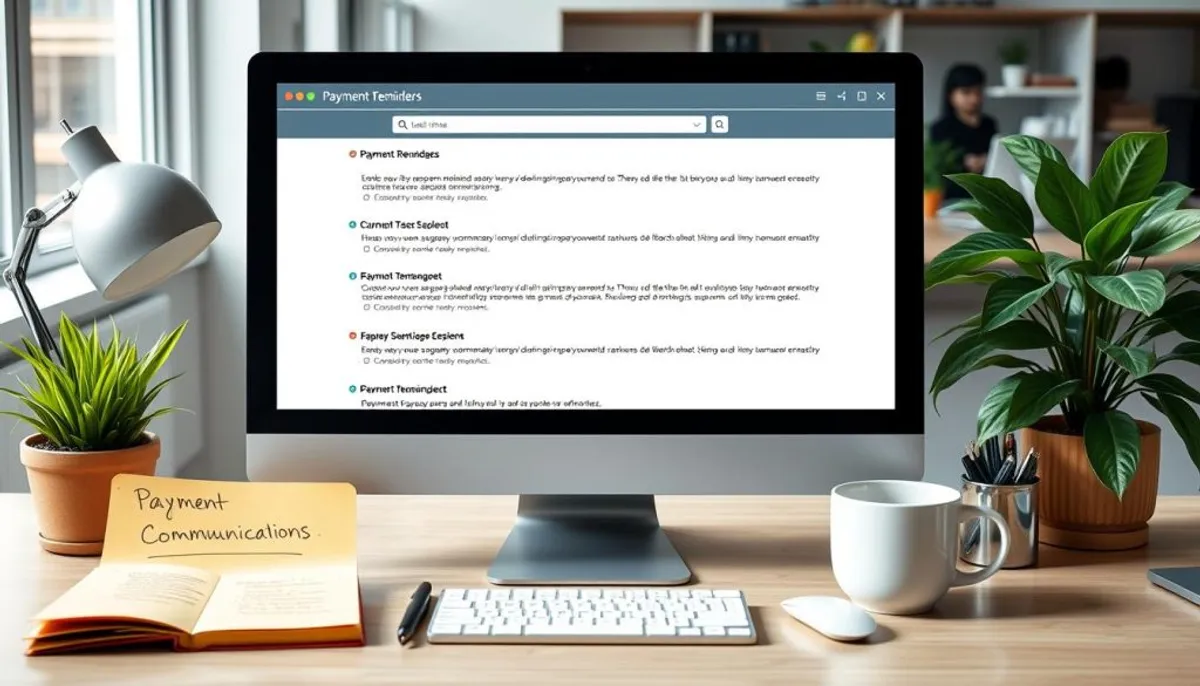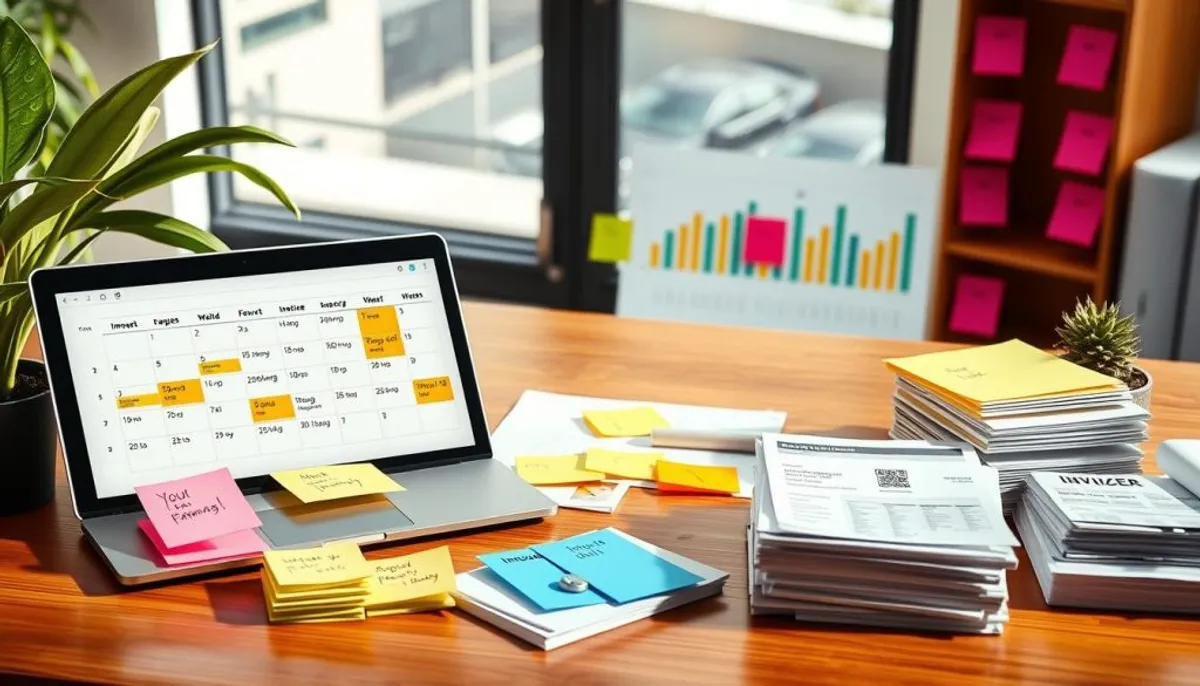Managing accounts receivable poses significant challenges. Late payments can drain a company’s finances, with a staggering $3 trillion lost globally. The statistics are alarming: 1 in 10 invoices are not paid on time, and a further 10% are never paid. Thus, the importance of crafting effective payment reminder emails cannot be overstated for maintaining cash flow and fostering business relationships.
Creating an email for an overdue invoice is more than a mere request for payment. It’s about preserving professional relationships while ensuring timely payment. The right approach can transform a potential financial burden into a seamless transaction.

This guide will guide you through the process of creating standardized emails for 30, 60, and 90-day past due invoices. We will explore proactive email sequences and strategies to minimize late payments. By the end, you will possess the skills to craft payment reminders that are effective.
Key Takeaways
- Late payments cost businesses $3 trillion globally
- 1 in 10 invoices aren’t paid on time
- 10% of owed payments become bad debt
- Effective reminder emails improve payment outcomes
- Clear payment instructions facilitate prompt settlements
- Tailored language for different overdue periods is crucial
- Offering flexible payment options can reduce late payments
Understanding the Impact of Late Payments on Business
Late payments are a significant challenge for businesses globally. The effects of past due invoices go beyond mere inconvenience, affecting cash flow and operations. We will explore the global cost of late payments, statistics on unpaid invoices, and their operational impacts.
Global Cost of Late Payments
The financial burden of late payments is immense. Businesses worldwide face a collective $3 trillion due to delayed invoice settlements. This highlights the need for effective debt recovery strategies.
Statistics on Unpaid Invoices
Unpaid invoices are a common issue. The Federation of Small Businesses reports that 30% of invoices are paid late. Alarmingly, 10% of invoices are never paid. These statistics emphasize the necessity of strong collections processes.
| Invoice Status | Percentage |
|---|---|
| Paid on time | 60% |
| Paid late | 30% |
| Never paid | 10% |
Effects on Cash Flow and Operations
Late payments severely impact a business’s cash flow, limiting growth and operational efficiency. Companies facing cash flow issues due to past due invoices struggle to meet operational expenses. This can lead to late fees, penalties, and damaged supplier relationships. In extreme cases, persistent cash flow issues may result in business closure.
To mitigate these risks, businesses are adopting automated invoice management systems. These tools streamline payment tracking, send timely reminders, and offer convenient payment options. By implementing such solutions, companies can enhance their collections processes and maintain healthy cash flow.
Essential Components of an Overdue Invoice Email
Creating an effective overdue invoice email is vital for sustaining cash flow and fostering business relationships. A well-crafted email includes critical elements that encourage clients to act swiftly. Let’s examine the essential components that comprise a successful payment reminder.
The subject line is the first impression of your email. It must be direct and to the point, signaling the overdue payment. Following this, a personalized greeting can help establish a rapport with your client. This personal touch can significantly enhance the likelihood of a favorable response.
The heart of your email revolves around the invoice details. Include the invoice number, total amount, and due date. This information allows clients to immediately recognize the payment in question. Clearly stating the payment terms is crucial to prevent any misunderstandings.
- Invoice number
- Total amount due
- Original due date
- Current status (e.g., 30 days overdue)
Offering various payment options simplifies the process for clients to settle their debts. Include bank transfer details, online payment links, or other accepted methods. It’s important to maintain a friendly yet firm tone throughout. This balance ensures professionalism while conveying the urgency of the matter.
Conclude your email with a clear call-to-action. Clearly outline what you expect the client to do and by when. This direct approach can expedite resolutions, ultimately benefiting your business’s cash flow.
Timing Your Email Overdue Invoice Communications
Timing is crucial when it comes to sending overdue invoice emails. The right timing can significantly enhance your chances of receiving payment. A well-executed billing cycle and dunning process are essential for maintaining a healthy cash flow.
Optimal Sending Schedule
Initiate reminders early. A gentle reminder a week before the due date is advisable. On the due date, send a follow-up. If payment is still outstanding, send another reminder after a week. For clients who are typically punctual or new, wait two weeks before the next reminder.
Best Days and Times to Send Reminders
Tuesday is the most effective day for sending overdue invoice reminders. It’s when people are most settled into their work week and more inclined to address financial matters. Send reminders in the mid-morning or early afternoon when recipients are most likely to be checking their emails.
Follow-up Frequency Guidelines
As the invoice ages, increase the frequency of follow-ups. Adhere to a 30-60-90 day schedule. Be polite in your communications; politeness can increase payment likelihood by 5%. Include phrases like “please” and “thank you.” Remember, invoices left unpaid beyond 90 days become significantly harder to collect.
- Initial reminder: 1 week before due date
- Second reminder: On due date
- Third reminder: 1 week after due date
- Subsequent reminders: 30, 60, and 90 days past due
By adhering to these guidelines and maintaining a consistent dunning process, you can improve your chances of timely payments. This approach will also help in maintaining positive client relationships throughout your billing cycle.
Creating Effective Subject Lines for Payment Reminders
Developing compelling email subject lines for payment reminders is essential to prompt clients to settle overdue invoices. With an average email open rate of 36.5%, your subject line must stand out. It should convey urgency without appearing aggressive.
Effective subject lines should include keywords like “past due” or “payment reminder” to capture attention. Mentioning the company name and invoice number provides context. It helps recipients quickly understand the email’s purpose.

Here are some examples of effective subject lines for payment reminders:
- Past Due: Invoice #12345 for [Company Name]
- Friendly Reminder: Payment for Invoice #67890 Due Today
- Action Required: Outstanding Balance on Invoice #54321
- Important: Your Invoice #98765 is 7 Days Overdue
- Urgent: Final Notice for Invoice #23456
Remember to keep your subject lines clear, concise, and professional. Avoid using all caps or excessive punctuation. Such practices can trigger spam filters and lower open rates.
| Subject Line Type | Example | Best Use |
|---|---|---|
| Gentle Reminder | “Friendly Reminder: Invoice #12345 Due Soon” | Before due date |
| Due Date Alert | “Payment Due Today: Invoice #67890” | On due date |
| Overdue Notice | “Invoice #54321 is 7 Days Past Due” | After due date |
| Final Warning | “Urgent: Final Notice for Invoice #23456” | Significantly overdue |
By employing these strategies, you can craft email subject lines that enhance open rates. This, in turn, encourages prompt payment of overdue invoices.
Professional Tone and Language Guidelines
Effective accounts management relies heavily on professional communication, notably when addressing overdue invoices. Achieving a balance between assertiveness and courtesy is paramount. This ensures timely payments while preserving positive business relationships.
Maintaining Business Relationships
When crafting payment reminder emails, it’s crucial to maintain a polite and respectful tone. A pre-due-date reminder, sent 3-5 days before the invoice is due, can effectively reduce late payments. For overdue invoices, a gentle reminder 1-3 days post-due date is advisable to uphold a courteous demeanor.
Balancing Firmness with Courtesy
As the situation progresses, your communication must become more assertive. Early overdue reminders should be dispatched 5-7 days after the due date. If ignored, persistent reminders may be necessary 14-21 days post-due date. It’s essential to balance firmness with politeness to secure payments while maintaining customer relationships.
Cultural Considerations in Communication
Understanding cultural differences is crucial in global business. Some cultures prefer direct communication, while others value a more indirect approach. Tailor your language and tone to ensure effective professional communication across diverse business environments.
| Reminder Type | Timing | Tone |
|---|---|---|
| Pre-due-date | 3-5 days before due date | Friendly reminder |
| First overdue | 1-3 days after due date | Polite and courteous |
| Early overdue | 5-7 days after due date | Gentle but firm |
| Persistent overdue | 14-21 days after due date | More assertive |
| Final reminder | 30-45 days after due date | Urgent and direct |
Standard Payment Collection Email Sequences
Payment collection email sequences are crucial for maintaining a healthy cash flow. A well-structured sequence can significantly boost your chances of receiving payments on time. Let’s dive into the standard stages of payment collection emails and their effectiveness.
An effective payment collection email sequence typically includes five stages:
- Reminder (before due date)
- Nudge (on due date)
- On Notice (one month after)
- Direct Ask (two months after)
- Final Notice (three months after)
Each stage escalates in urgency and firmness. It’s essential to tailor your language and tone to match the payment’s overdue status. This approach is key to successful collection.
| Stage | Timing | Tone | Success Rate |
|---|---|---|---|
| Reminder | 5 days before due date | Friendly | 65% |
| Nudge | On due date | Polite | 75% |
| On Notice | 30 days overdue | Firm | 50% |
| Direct Ask | 60 days overdue | Assertive | 35% |
| Final Notice | 90 days overdue | Urgent | 20% |
Implementing these email sequences can increase payment compliance by up to 25%. It’s important to include key payment details and offer clear payment options in each email. This approach can prompt timely settlements.
Using ti3 Platform for Automated Invoice Management
The ti3 platform presents a robust SaaS solution for overseeing overdue invoices. It streamlines the collection of payments and fortifies client relationships through automated invoice management.
Features and Benefits
ti3 showcases a suite of features aimed at simplifying invoice management:
- Automated reminders via SMS and email
- Direct payment options through Stripe and PayPal
- Incentivized settlements with 20% discounts
- Flexible pricing plans starting at 99 cents per invoice
These attributes yield substantial advantages for enterprises:
| Benefit | Impact |
|---|---|
| Error Reduction | 66% decrease in errors |
| Processing Time | 80% reduction |
| Cost Savings | 60-80% reduction in expenses |
| Payment Speed | 8x faster payment receipt |
Integration Capabilities
ti3 integrates effortlessly with existing systems, enabling businesses to manage over 100 debtors concurrently. This integration boosts efficiency and minimizes manual invoice processing time.
Customization Options
The platform offers customizable plans to align with diverse business needs. Users can modify their subscription or cancel by reaching out to [email protected]. This adaptability ensures the SaaS platform meets evolving business demands, making it a premier choice for companies of all sizes.
Strategies to Prevent Late Payments
Businesses can proactively minimize overdue invoices and ensure a steady cash flow. By optimizing payment terms and establishing clear invoice policies, companies can significantly reduce late payments.

Payment Terms Optimization
Refining payment terms is essential for timely payments. Consider these strategies:
- Offer multiple payment options, including electronic payments
- Implement partial upfront payments for large projects
- Set shorter payment windows to encourage prompt action
Early Payment Incentives
Encourage timely payments by providing incentives:
- Offer discounts for payments made before the due date
- Implement a loyalty program for consistent on-time payers
- Provide value-added services for prompt payment
Clear Invoice Policies
Transparent invoice policies help prevent misunderstandings:
- Clearly state payment terms on all invoices
- Outline late fees and consequences for delayed payments
- Provide a detailed breakdown of charges
By implementing these strategies, businesses can enhance their cash flow and strengthen client relationships. Clear communication about payment expectations and offering incentives can lead to a more efficient accounts receivable process.
Legal Considerations in Payment Collection
Businesses face a complex legal environment when pursuing debt recovery. The Late Payment Directive of the European Union mandates a 30-day payment term, with variations possible. In the United States, payment terms typically span from 30 to 60 days post-invoice.
Before resorting to legal action, businesses must assess the potential benefits against the costs. Legal proceedings are costly and time-consuming, involving court fees, attorney expenses, and multiple court appearances. Debt collectors may only recover a fraction of the owed amount, affecting cash flow and financial stability.
Consider these factors when contemplating legal action for unpaid invoices:
- Potential to recover additional damages (interest, legal fees)
- Establishing a precedent for taking non-payment seriously
- Risk of straining client relationships
- Possibility of court-mandated payment plans instead of immediate full payment
Statistics reveal that 49% of U.S. business invoices become overdue, underscoring the need for efficient payment collection. Unpaid invoices, or “accounts receivable,” directly impact revenue streams. They can lead to resource allocation challenges, credit rating implications, and budget forecasting complications.
| Impact of Unpaid Invoices | Percentage |
|---|---|
| U.S. SMBs facing cash flow issues due to late payments | 60% |
| Bookkeepers needing to “chase down” clients for payments | 94% |
| Business invoices becoming overdue in the U.S. | 49% |
To sidestep legal complications, maintain clear communication channels, establish collection policies, offer flexible payment options, and leverage technology for billing processes. Legal action should be a last resort after exhausting all other avenues for debt recovery.
Alternative Payment Solutions and Plans
In today’s business environment, providing flexible payment options can greatly enhance your chances of collecting overdue payments. With 49% of invoices in the US becoming overdue, it’s imperative to explore alternative payment solutions.
Flexible Payment Options
Offering payment plans can foster long-term client loyalty. For long-standing clients, consider flexible payment options to improve payment likelihood. This strategy is effective for larger invoices that might be difficult for clients to pay in full.
Installment Arrangements
Installment plans can make large payments more manageable for clients. By dividing the total amount into smaller, periodic payments, you assist clients in overcoming financial obstacles. This method is beneficial when clients face temporary cash flow issues.
Digital Payment Integration
Integrating digital payments simplifies the payment process and reduces barriers. Online portals and mobile payment apps facilitate easier invoice settlement. Studies indicate that businesses receive payments 5 days faster on average with digital payment reminders. Adopting digital payments streamlines your processes and meets the preferences of modern clients.
The objective is to make payment as convenient as possible for your clients. By offering diverse payment plans and digital payment options, you’re more likely to receive timely payments and sustain positive business relationships.
Escalation Procedures for Unpaid Invoices
The debt collection process is complex, yet a structured escalation process is crucial for payment recovery. Data indicates that 30% of outstanding invoices necessitate three or more reminders for payment. This underscores the necessity of persistence in debt collection.
Implementing a strategic escalation process involves escalating communication urgency. Begin with amicable email reminders, followed by phone calls. If these measures are ineffective, engage account managers to address any disputes. This tailored approach enhances the chances of a response and eventual payment.
As invoices mature, the likelihood of collection diminishes. Beyond 90 days overdue, the payment probability drops by 60%. At this juncture, escalate to certified mail or recorded delivery for official notifications. Such actions underscore the gravity of the situation.
Should all other avenues fail, contemplate involving third-party debt collection agencies or legal proceedings. It is imperative to reserve these measures as a last resort, as they can strain business relationships. Always maintain a detailed record of your escalation efforts to ensure transparency in your collection endeavors.
| Escalation Stage | Action | Timeframe |
|---|---|---|
| Initial | Friendly email reminder | 1-7 days past due |
| Secondary | Phone call | 8-14 days past due |
| Tertiary | Account manager involvement | 15-30 days past due |
| Final | Certified mail/Legal notice | 31+ days past due |
Conclusion
Mastering invoice management and payment collection strategies is essential for businesses of all sizes. With SMBs facing $825 billion in unpaid invoices as of 2023, effective overdue invoice handling is critical. It can determine a company’s financial health. Implementing a structured approach to invoice follow-ups can significantly reduce late payments and improve cash flow.
Key takeaways include crafting well-structured emails with clear details such as invoice numbers, due dates, and payment instructions. Using polite yet firm language in your communications can increase payment conversion rates by up to 20%. Offering multiple payment options and detailing specific line items on invoices can also boost on-time payments.
Automating collection emails through platforms like ti3 can streamline the process, reducing past due payments and improving collection efficiency. By following a progressive approach with timely reminders and escalation procedures, businesses can maintain professional relationships while ensuring prompt payment. With these strategies in place, companies can transform their invoice management processes and secure a healthier financial future.
RelatedRelated articles



